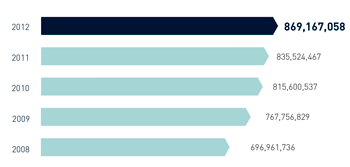Environmental indicators
The Inditex system of indicators shows the environmental impact of the Group in terms of consuming natural resources, using energy, generating waste and generating atmospheric emissions. These indicators are expressed by number of garments released on the market. This reflects the efficiency of all areas of the Company (manufacturing, head office, chain head offices, logistics centres and stores). These relative indicators show that greenhouse gas (GHG) emissions have been significantly reduced, thus reflecting the success in integrating innovative environmental management into all phases of the business. The scope of the indicators includes Inditex’s own premises in Spain and all the stores owned by the Group worldwide.
The guidelines of the Intergovernmental Panel on Climate Change, IPCC (Guidelines for National Greenhouse Gas Inventories, 2007) and the World Resources Institute GHG Protocol (2008) are used to calculate GHG emissions. The following emission factors have been used for the different types of energy:
- Natural gas: 0.2025 Kg CO2eq/kWh
- Diesel: 2.6919 Kg CO2eq/kWh
- Electricity from the grid: 0.300 Kg CO2eq/kWh
The emission factors applied to natural gas and diesel come from the GHG Protocol for Stationary Combustion v.4.0 by the World Resources Institute. The electricity emission factor comes from the Catalan Office for Climate Change and corresponds to the emissions associated with the Spanish electrical mix in 2012.
The values used in the ratios are the following:
Ratio= (absolute value of the year/number of garment released on the market during the year) x 1000.
The environmental indicator system includes data from 1 February 2012 to 31 January 2013, except for waste generation, which refers to the calendar year. This resolves the discrepancy with previous years between the sustainability balance sheet and the Inditex tax year.
Garments released on the market*



